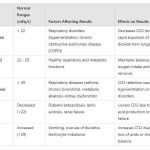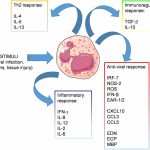When you receive your blood test results, it’s normal to feel overwhelmed and unsure of what all the numbers and codes mean. One important aspect is the RDW-SD value, which stands for Red Blood Cell Distribution Width-Sigma. In this blog post, we’ll break down the significance of RDW-SD and provide a comprehensive guide to help you understand your blood test results.
What is RDW-SD?
RDW-SD is a laboratory value that measures the variation in red blood cell size. It’s an important indicator of certain health conditions, including anemia, bone marrow disorders, and autoimmune diseases. A high RDW-SD reading can indicate that your body is producing abnormal or immature red blood cells.
What Does a High RDW-SD Reading Mean?
A high RDW-SD value typically indicates that there’s something amiss with your red blood cell production. This could be due to various factors, such as:
- Inadequate iron levels
- Vitamin deficiencies
- Bone marrow disorders
- Autoimmune diseases
In our next section, we’ll delve deeper into the possible causes of a high RDW-SD reading and explore what you can do to address this issue.
In our previous section, we introduced you to the concept of RDW-SD and its significance in blood test results. Now, let’s dive deeper into what a high RDW-SD reading means and explore possible causes.
Causes of High RDW-SD
A high RDW-SD value can be caused by various factors that affect red blood cell production. Some common causes include:
- Inadequate iron levels: Low iron levels in the body can lead to anemia, which is characterized by abnormally small red blood cells. This can result in a high RDW-SD reading.
- Vitamin deficiencies: Deficiencies in vitamins like B12 and folate can also contribute to anemia and abnormal red blood cell production, leading to a high RDW-SD value.
- Bone marrow disorders: Certain conditions, such as myelodysplastic syndrome (MDS) or aplastic anemia, can affect the bone marrow’s ability to produce healthy red blood cells, resulting in a high RDW-SD reading.
- Autoimmune diseases: Conditions like rheumatoid arthritis, lupus, and celiac disease can cause the immune system to attack healthy tissues, including red blood cells, leading to anemia and a high RDW-SD value.
- Infections: Certain infections, such as malaria or babesiosis, can also affect red blood cell production and lead to a high RDW-SD reading.
It’s essential to note that a high RDW-SD reading can be a sign of an underlying condition that requires medical attention. If you have a high RDW-SD value, it’s crucial to consult with your healthcare provider to determine the underlying cause and develop an appropriate treatment plan.
What to Do Next
If you’ve received a blood test result with a high RDW-SD value, what can you do next? The first step is to schedule an appointment with your healthcare provider to discuss your results. They will likely perform additional tests to determine the underlying cause of your high RDW-SD reading and develop a personalized treatment plan.
In the meantime, it’s essential to maintain open communication with your healthcare provider and ask questions about your test results and any treatment options that may be available. Remember, a high RDW-SD value is not a diagnosis in itself, but rather an indicator of potential health issues that require further investigation and management.
For more information on blood tests and what they can reveal about your health, check out the American Society of Hematology’s (ASH) website or consult with your healthcare provider.
Consult a Medical Expert
Get personalized guidance on your blood test results from experienced medical professionals.
Consult a Medical ExpertIn our previous sections, we’ve covered what RDW-SD is, its significance in blood test results, and what a high reading can mean for your health. Now, let’s summarize the key points:
- RDW-SD measures red blood cell size variation.
- A high RDW-SD value indicates abnormal or immature red blood cells production.
- Possible causes of high RDW-SD include inadequate iron levels, vitamin deficiencies, bone marrow disorders, and autoimmune diseases.
Now that you have a better understanding of what RDW-SD means for your health, it’s essential to take proactive steps towards addressing any underlying issues. If you’ve received a high RDW-SD reading, consider the following:
- Talk to your doctor about your results and discuss potential causes.
- Work with your healthcare provider to develop a personalized plan for managing your condition. Don’t hesitate to seek a second opinion or consult with a specialist if you’re unsure about your diagnosis or treatment options.
In conclusion, RDW-SD is an important indicator of red blood cell production and health. By understanding what it means and taking steps to address any issues, you can take control of your well-being and work towards a healthier, happier life. Remember, staying informed and proactive about your health is key to achieving optimal wellness.
Thanks for joining us on this journey through the world of RDW-SD! We hope you’ve gained valuable insights and are empowered to take charge of your health. If you have any questions or concerns, please don’t hesitate to reach out. Until next time, stay healthy and happy!
The ultimate guide to intermittent fasting for women: Want to unlock the benefits of intermittent fasting as a woman? From weight loss to energy boosts, discover how this powerful dieting method can transform your life. Start your journey now!
Ask a CPA a question online for free: Got questions about taxes or financial planning? Get expert advice from a certified public accountant without breaking the bank! Click to ask your questions and start building your financial future.



